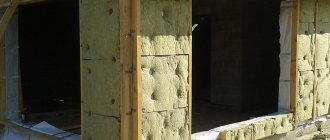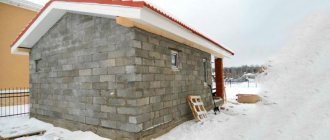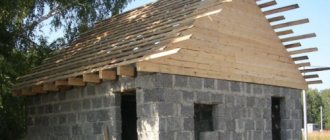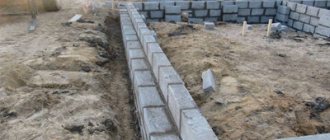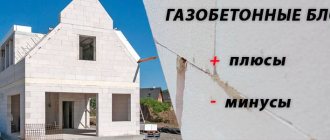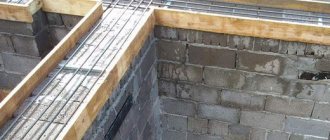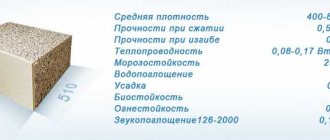Properly selected insulation materials help improve and maintain the quality of laid walls and help save costs on the use of heating and electricity resources.
They also help the walls cope with the formation of condensation, protect them from cold, noise and sounds. How to insulate an expanded clay concrete bath, and which heat insulators are most suitable for this, read in the proposed material.
The need for thermal insulation of walls
The practical significance of using thermal insulation for a bathhouse is that it allows you to use less fuel and also warm up the steam room much faster. Technologically correct insulation helps protect the bathhouse from mold and fungi , extending its service life.
Insulation of a bathhouse built from expanded clay concrete is required according to the recommendations of such regulations as:
- GOST 32488-2013 – External walls made of expanded clay blocks.
- SNiP 02/23/2003 – Thermal protection of the bath complex.
- STO 501-52-01-2007 – Design and construction of structures.
- STO-NO "SPKiK" -001-2015 – Expanded clay concrete buildings.
According to the listed standards, all expanded clay concrete blocks, including bathhouses, must be insulated from the outside, from the inside, and also from both sides simultaneously, in regions with low temperatures throughout the year. In this case, the thickness of the wall (pie of all layers) must be at least 65 cm.
The thermal conductivity of expanded clay concrete is 0.15-0.45 W/m2. The presented characteristic indicator is considered good, but the walls are subject to thermal insulation without fail, since such a step helps to preserve the porosity of the structure of the building stone, protect its surface from external factors and high humidity.
The best insulation materials for expanded clay concrete blocks are considered to be expanded polystyrene or mineral wool slabs. In addition to heat-saving properties, these materials repel water well. It is better to select natural insulators for the steam room . Namely, these types are environmentally friendly and do not contain toxins, as they are made in the process of processing natural substances.
Expanded polystyrene and mineral wool are recommended by manufacturers for walls exposed to hot temperatures and humidity. Thermal insulators are non-flammable and retain their shape, even after several years of constant use of the room.
In addition, they are recommended for expanded clay concrete baths due to their characteristic resistance to mold fungi. In addition, they are also sold at an affordable price.
Important! The process of thermal insulation of the bath must be carried out according to all technological rules, not forgetting to also use foil material.
Subtleties and useful tips for insulating a house made of expanded clay concrete
Each case has its own nuances, which professionals, as a rule, are in no hurry to share. Using solid experience in communicating with manufacturers and building insulation specialists, we have accumulated a sufficient arsenal of information that may be useful. So, here's what you need to remember when calculating the plan for insulating a house from KBB: 1Integrated approach It is most justified to carry out insulation of the entire house as a complex, without losing sight of the foundation. If this is not possible, do everything gradually. 2 Location of insulation The main thermal insulation systems should be located outside the building. 3 Insulation inside the house Sometimes you can complete the insulation with individual components from the inside. But this requires a professional and balanced approach.4 Work procedure The facade of individual construction accounts for a fifth of all heat losses. It’s better to start with the roof, then work on the walls and finish with communications and the foundation. 5 Alternative If you want to do without insulation, build a wall thickness of 600 mm or more. 6 Professional help Illiteracy in insulating a house made of expanded clay blocks is fraught with significant financial losses and disappointment. Work with companies that thoroughly know the materials and professionally fulfill their obligations. Remember: whatever insulation you choose, the construction result largely depends on the quality of the source materials. At the KBLOK site you will find reliable expanded clay concrete manufacturers who will not only be able to give professional advice on laying walls from KBB, but also, by individual agreement, provide the services of specialists in construction and insulation. We personally check the products of all suppliers from our catalog, so we are sure that they are not afraid to entrust projects of any level of complexity.
Layering scheme
Laying all layers of the wall (pie) of a bathhouse with external and internal insulation together may look like the one shown in the photo:
The scheme may be slightly different only for the southern regions, where external thermal insulation is practically not used , limited only to bitumen waterproofing and external finishing, in the form of siding with any natural stone, plastic panels or decorative brick.
Standard layers of a bath with a heat insulator include the following sequence of layers:
- Facing layer.
- External plaster with insulation.
- Waterproofing layer (for example, roofing felt).
- Wall made of structural load-bearing blocks.
- A layer of bitumen waterproofing.
- Selected insulation material attached to a wood or aluminum frame.
- A layer of foil material for additional vapor barrier.
- Ventilated gap.
- Additional sheathing with clapboard.
Experts recommend using high-quality building materials – pine, birch, linden, beech, larch – as interior finishing for wooden eurolining.
Advantages of a bathhouse made of expanded clay concrete blocks
High speed of construction. Due to the large size of the blocks, it will be possible to erect the building frame quickly. The walls are smooth, they do not need to be leveled before finishing. The building has a long service life.
It will last for at least 35 - 50 years. Low price for building materials. Easy installation. Even a non-professional can handle the construction of the frame. Environmental friendliness. The blocks contain no hazardous elements. Mold and fungal formations do not appear on the walls. Fire safety, the blocks are assigned a non-flammability class of A1.
How to insulate: suitable materials
Construction experts believe that expanded clay concrete is best combined with mineral wool and expanded polystyrene slabs . That is why they recommend using these materials as insulation for bath walls.
First of all, both of these materials have good vapor barrier and air exchange, and these qualities are used as an important element of characteristics that actively prevents the formation of condensation inside the walls of premises, which makes the formation of fungi and mold impossible. The lower the vapor barrier numbers, the better for the overall thermal conductivity of the walls.
Mineral wool and expanded polystyrene help create a favorable microclimate and comfortable temperature in the room even at the stage of installation work. Especially, these insulation materials are recommended for regions with harsh climatic conditions.
Mineral wool:
Polystyrene foam insulation:
The advantages of materials include saving money spent on heating (stove, steam), when you do not need to spend additional money on using electric convectors.
Mineral wool and expanded polystyrene are found in slabs and rolls . Each master independently chooses what exactly is convenient for him to work with. Any of the presented materials is affordable, and is often installed inside plasterboard structures, taking into account the installation of additional vapor barrier.
The compositions of materials differ in hardness and characteristic features for improving the composition, which are indicated by manufacturers on product labeling. The peculiarity of expanded polystyrene is its division into ordinary and extruded.
Both varieties do not absorb moisture, are not afraid of mechanical stress, have good adhesion , elasticity, dimensional stability and low weight, are easy to process and fasten using polyurethane glue, foam, as well as fasteners installed on the frames.
Important! Roofing felt is used as a waterproofing layer between expanded clay concrete and insulation.
Masonry mortar
Laying with special glue is possible if the blocks are even. Irregularities of more than 2 mm (characteristic of most expanded clay concrete wall stones) force the preparation of a cement-sand mixture (10 and 30 parts, respectively). Water - about 7 parts, to a plastic, but not runny consistency.
Giving up glue does not upset those who know: by changing the thickness of the seam you can eliminate the unevenness of the rows below.
Information. It is more convenient and efficient to mix the masonry mixture in a concrete mixer. A stationary container and a submersible mixer will cope with the task, but will not prevent the finished solution from delaminating.
The composition of the ready-made mixtures is supplemented with plasticizers and forms seams that are almost twice as thin as homemade ones.
Permissible actual thickness of the masonry mortar layer:
- glue - 2–3 mm;
- ready-made cement-sand composition - 8–10 mm;
- mixture of sand and cement - 1 - 3 cm (joint thickness - 1 cm, the rest is filling in unevenness).
It is good if the thermal conductivity of the masonry mortar and the wall material does not differ much.
“Insulate” the masonry composition (reduce the thermal conductivity coefficient) with perlite and expanded clay sand. They are added to the cement-sand mortar or purchased ready-made mixture, where they are already contained in the composition.
It is also possible to additionally insulate the masonry with polyurethane foam, which can divide the masonry into 2-3 parts (if you look along the wall), thereby interrupting the “cold bridges”.
Tools and consumables
To install an insulating layer in an expanded clay concrete bath, you may need:
- Certified slabs (or rolls), with the specified factory markings and instructions, calculated in the required quantity.
- Construction tape, sharp utility knife, large scissors.
- Reinforcing mesh with standard cell size.
- Brushes and brushes of various sizes.
- Glue and foam (polyurethane).
- Primer and mastic (bitumen or universal).
- Vapor barrier membrane or foil material.
- Fastening elements (screws, angles, dowels, aluminum sticks).
- A container for diluting glue (if you need to prepare it yourself).
- Work clothes, shoes, gloves, glasses.
- Screwdriver, drill.
If the insulation is carried out by a construction company with which the customer has signed an agreement, then there is no need to independently purchase tools and consumables.
The company has all the necessary tools, and it will provide the necessary materials for the work itself, in accordance with the project estimate. Some rolled types of insulation are found immediately with a foil layer .
This greatly simplifies the process of improving the premises and saves costs on separate purchases, and the separate arrangement of layers of insulation and separately - foil. 1 roll of such compact material (replaces two) = 1 insulation + foil sheet, which further increases the speed of work.
Thermal calculation
When purchasing blocks, the manufacturer must always indicate their properties. The calculation determines the thickness; to perform it, a characteristic such as thermal conductivity will be required. There are two ways to perform this calculation:
- "manually";
- using special programs.
It is not difficult to perform an independent calculation, but for a person who does not have a construction education, it can cause difficulties. It is best to use the simple Teremok program, which works in two modes:
- calculating the thickness of one of the layers of the wall structure;
- checking the heat transfer resistance if the thickness has already been selected.
To work with the software, you will need the following initial data:
- thermal conductivity of expanded clay concrete blocks;
- block width;
- thermal conductivity of insulation;
- insulation thickness (not needed if working with the program in the first mode).
Having selected the values, you can begin insulating the walls of the house.
How to do it correctly: stages
The step-by-step guide to using insulation for an expanded clay concrete bath is the same for all heat insulators used, which are used in slabs and rolls. The technology for internal and external insulation is absolutely the same. The nuances of the work are as follows :
- Creation of an internal lathing made of wood or aluminum, around the perimeter of insulated expanded clay concrete wall blocks, with slats 5 cm thick. The lathing will then be useful for arranging a bathhouse with eurolining.
- Then they begin laying the insulation on dry, prepared (cleaned from dust) walls with the required amount of glue applied to the surface, paying special attention to the tightness of the joints, and not forgetting about the ventilation gap (20 cm). The insulation is pressed firmly against the wall and secured with dowels.
- A layer is made of foil material if it is not part of the thermal insulation material.
- Mount the mount mesh to the corners along the edges, and secure it around the entire perimeter.
- The finishing is made from the selected wood lining.
Insulation is always carried out only after waterproofing has been completed. Outside, you can use any type of plaster on the mesh, but for a bathhouse made of expanded clay concrete, it is better to use brick or good siding that protects from wind and frost. In addition, external insulation will not allow the bathhouse to cool down quickly.
In order to maintain a comfortable temperature in a bathhouse made of expanded clay concrete, professionals recommend simultaneously insulating the floors - this can be water heating or well-made floors with a high base and a warm ASG cushion inside. At the same time, using foil material, under the eurolining, the ceiling is also insulated.
Important! If dimensional blocks were used in the construction, which, with the standard parameters of walls with a maximum thickness of 65 cm, reach a width of 70 cm, then there is no need to install external insulation for such a bathhouse. The cladding will be quite sufficient.
Features of using expanded clay when insulating the ceiling of a bath room
When insulating the ceiling of a bathhouse using expanded clay, the characteristics of the building material should be taken into account. It is not recommended to insulate with expanded clay if there is no attic space above the ceiling, since this material is capable of absorbing moisture. In the absence of an attic space, this may negatively affect the thermal insulation properties of the material. In addition, the moisture absorbed by the material contributes to the weighting of the material, which increases the load exerted by the insulation on the floors of the premises of the bathhouse complex.
In order to avoid such a situation when installing an expanded clay insulation layer, additional waterproofing should be laid, which will prevent moisture from penetrating from the air to the insulation layer. A layer of insulation should be placed on top of a layer of expanded clay.
Making a layer of insulation using expanded clay is quite simple, since during the installation process it is not necessary to adjust the elements and carry out fastening work. During the work, it should be remembered that expanded clay, like any other bulk material, is capable of generating a large amount of dust when working with it. For this reason, it is recommended not to pour this building material onto bare boardwalks. To prevent dusting, it is recommended to lay expanded clay on a prepared substrate.
Before using expanded clay as the main insulating building material for the ceiling, the feasibility and effectiveness of using expanded clay should be analyzed. This is required due to the fact that the effectiveness of the material appears only with a layer thickness of over 100 mm.
To ensure high-quality thermal insulation, in some cases it may be necessary to form an insulating layer from 200 to 400 mm. Before forming a layer of insulation in the thickness of the floor, you will need to lay a layer of hydro- and vapor barrier between the floor boards and the layer of heat-insulating material.
Possible difficulties and errors
Errors in the process of insulating a bathhouse made of expanded clay concrete blocks can occur only in a few cases:
Buying low-quality material.
When purchasing expanded polystyrene or mineral wool, you should definitely ask the seller for a factory quality certificate, marking according to Russian standards and instructions for use.This applies not only to insulation, but also to the adhesive composition, mounting fasteners and frames.
- Violation of technological rules in the arrangement of insulation - failure to follow the sequence of actions, laying the material on wet walls, without a lack of waterproofing, as well as a ventilation gap. The steps should be performed sequentially, not forgetting about ventilation and proper distribution of glue.
- High-speed drying of the room with heat construction guns. It is best if the glue and material gain strength and dry gradually, and not at high speed. With slow drying, the adhesive properties of the material are better revealed, and the speed mode negatively affects the quality of the created structure.
- Work in a room with a temperature less than +5°C. Despite the fact that modern manufacturers produce material that is cold-resistant, and some types of glue can be used at low temperatures, nevertheless, according to technological rules and building codes, work above +5°C in dry weather is a more appropriate solution.
- Saving on adhesive solution. In this case, you should not use less glue than indicated in the instructions. Doing a huge amount of work, then being greedy on purchasing adhesive is a bad idea. Therefore, it is better to purchase the required amount of glue for insulation and apply it as indicated in the instructions.
Any sales consultant in a construction supermarket can help with calculations of the required amount of glue when purchasing it. The consumption is indicated on the product packaging. On average, 3.5-5.5 kg/m2 is the standard for glue consumption , but it all depends on the chosen brand and its consistency. Experienced builders recommend using adhesive grade M50 and higher.
Useful video
Below is a video that describes in detail the insulation process of a block bath. Before you begin installation yourself, you should carefully read both theoretical materials and video broadcasts on this topic. This video will also answer questions about how to insulate a foam block bathhouse and how to insulate a cinder block bathhouse.
With a responsible approach to insulating a bath structure, you can provide yourself with a real health resort on the territory of your summer cottage.
Features of external work
Initially, it is advisable to prepare and plaster the facade in order to achieve acceptable evenness of the walls and fill existing cracks and crevices. Most often, the facade of aerated concrete baths is sheathed with mineral wool or expanded polystyrene. In the first case, the walls are first covered with rolled materials to protect the insulation from moisture.
If polystyrene foam boards are a priority, they can be fixed on external surfaces without worrying about laying guides in advance; This is where special glue or polyurethane foam comes in handy. Next, the panels are additionally fixed with dowels, the joints and seams are filled with foam. A sheathing for installation of siding is stuffed on top: this sheathing will help protect the insulation from mechanical damage and exposure to ultraviolet radiation.

